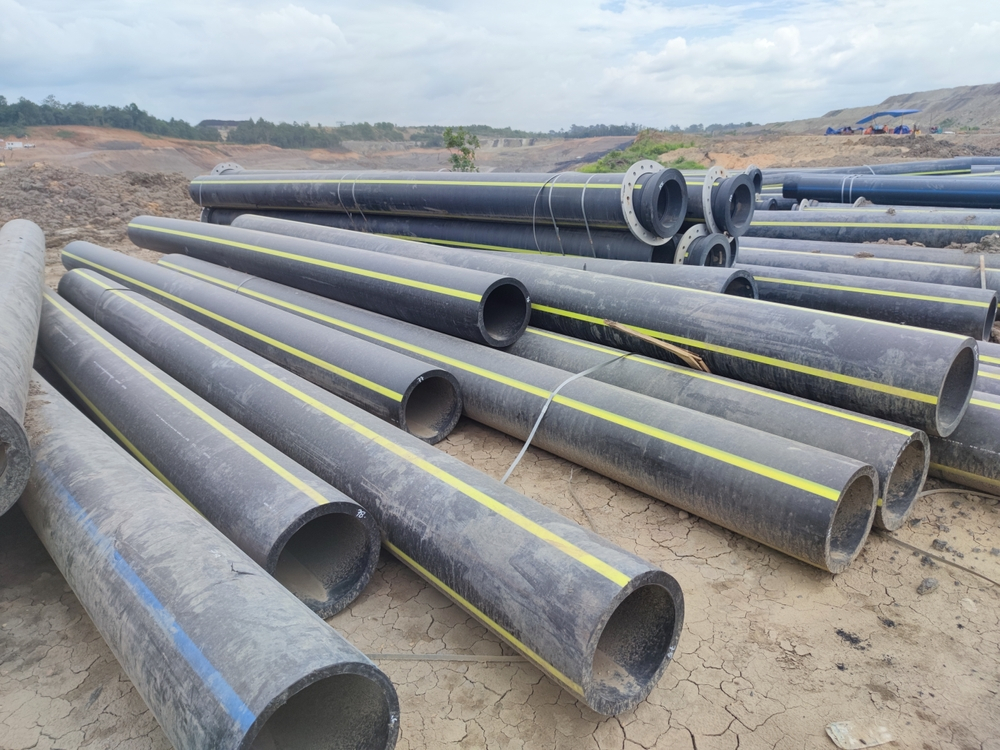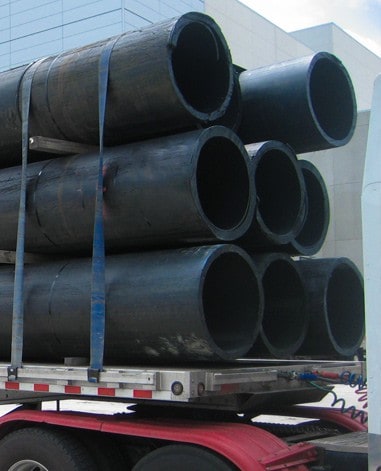How American Plastics HDPE Pipe Manufacturing Maintains High Standards
Explore the Production Refine Behind High-Quality HDPE Pipe and Its Applications
The production process of top quality HDPE pipes is intricate and systematic. It begins with the option of raw products that boost efficiency. Following this, ethylene goes through polymerization to form material, which is after that shaped with extrusion. Quality control is critical, making certain that the last product meets strict requirements. However, the trip of HDPE pipelines doesn't end with production. Their applications across numerous industries disclose a more comprehensive value worth examining.
Recognizing HDPE: Characteristics and Advantages

High-density polyethylene (HDPE) is a flexible polycarbonate understood for its resilience and resistance to different environmental elements. This product displays exceptional tensile toughness, making it suitable for demanding applications. Its low-density framework contributes to a lightweight product, assisting in ease of taking care of and installation. HDPE also showcases amazing resistance to chemicals, which lessens destruction when exposed to rough substances.
The material's low moisture absorption further boosts its longevity, making it ideal for use in pipes and storage space tanks. Furthermore, HDPE is immune to ultraviolet (UV) radiation, making sure that items keep their honesty even when revealed to sunshine. Moreover, its flexibility enables for the production of elaborate shapes without endangering strength. The environmentally friendly nature of HDPE, often originated from recycled materials, includes to its charm, advertising lasting practices in production. On the whole, these homes and advantages make HDPE a preferred option for various industrial and consumer applications.
Resources Option for HDPE Production
The choice of raw products for HDPE production is necessary to confirm the last product fulfills the preferred requirements and high quality standards. High-density polyethylene (HDPE) is primarily produced from polymerized ethylene, obtained from fossil fuels such as natural gas or unrefined oil. The high quality of these feedstocks considerably affects the mechanical and thermal properties of the final HDPE.
Additives likewise play a considerable function in boosting HDPE's performance, consisting of antioxidants, UV stabilizers, and colorants, which improve resilience and resistance to ecological elements. The option procedure need to take into consideration not only the chemical structure of the raw products however likewise their handling attributes to guarantee effective manufacturing.
Moreover, the sourcing of raw products need to focus on sustainability and compliance with ecological laws, as accountable methods are crucial in today's market. Inevitably, mindful resources option lays the foundation for generating high-quality HDPE pipelines appropriate for diverse applications.
The Extrusion Process: Shaping HDPE Pipe
The extrusion process plays an important function fit HDPE pipelines, beginning with meticulous product preparation methods that guarantee optimal flow and consistency. Just as vital is the style of the die, which directly influences the last measurements and surface area quality of the pipeline. With each other, these aspects add substantially to the efficiency and high quality of HDPE pipeline production.
Material Prep Work Techniques
Reliable manufacturing of HDPE pipes starts with precise product preparation strategies, specifically the extrusion procedure. During this stage, high-density polyethylene material is first dried out to eliminate moisture, making certain perfect flow qualities. The resin is after that fed right into the extruder, where it undertakes home heating and melting, changing right into a viscous state. This home heating process is meticulously managed to keep the material's integrity and performance. The liquified HDPE is forced with a die, forming it into a continual pipe form. Correct temperature level administration throughout extrusion is vital, as it directly impacts the product's properties and the end product high quality. When formed, the HDPE pipe is cooled down and cut to specified sizes, ready for subsequent processing and applications.
Die Style Significance
Precision in die design plays a crucial duty in the extrusion procedure of HDPE pipes. The die functions as the final shaping device, directly affecting the pipe's measurements, wall density, and surface finish. A well-designed die assurances uniform product flow, lowering defects such as irregularities and weak points. The geometry of the die must be maximized to accommodate the details residential or commercial properties of HDPE, including its thickness and thermal habits during extrusion. In addition, the cooling price of the product as it passes through the die can considerably affect the pipeline's structural honesty. Consequently, buying sophisticated die modern technology is vital for manufacturers intending to generate top notch HDPE pipelines that satisfy sector criteria and consumer assumptions.
Quality Assurance Procedures in HDPE Manufacturing
Although different variables influence the high quality of HDPE pipeline production, reliable quality assurance measures are essential to guarantee uniformity and integrity in the hop over to here end product. Secret quality assurance techniques include extensive material assessment, validating that the raw polyethylene fulfills well established requirements for purity and thickness. Throughout the extrusion procedure, parameters such as temperature level, pressure, and cooling time are closely checked to preserve dimensional accuracy and structural honesty
Additionally, post-production screening is essential; suppliers often carry out hydrostatic tests to examine the pipe's strength and resistance to pressure. Aesthetic assessments for surface area flaws better boost quality control. Qualification from relevant standards organizations, like ASTM or ISO, gives an additional layer of reliability. By implementing these thorough quality assurance measures, manufacturers can decrease issues, improve efficiency, and guarantee that the HDPE pipelines meet the details requirements of various applications, inevitably leading to customer satisfaction and rely on the product.
Applications of HDPE Pipeline Throughout Industries
HDPE pipelines are used throughout different fields as a result of their discover here durability and flexibility. In water circulation systems, they assure reliable shipment, while in wastewater administration, they provide trusted services for waste transport. Additionally, farming irrigation networks gain from HDPE's resistance to rust and versatility, making it an excellent option for contemporary farming practices.

Water Circulation Systems
A substantial variety of sectors rely upon high-density polyethylene (HDPE) pipes for reliable water circulation systems. Understood for their toughness and resistance to deterioration, HDPE pipelines are extensively utilized in metropolitan water system networks, farming irrigation, and industrial applications. Their light-weight nature assists in easy handling and installment, lowering labor costs and time. Furthermore, HDPE pipelines can accommodate various stress levels, making them appropriate for both low and high-pressure systems. hdpe pipe in stock Midland TX. The adaptability of the product allows for seamless combination right into existing framework, decreasing the requirement for extensive excavation. In addition, HDPE's resistance to chemical seeping guarantees that the water provided remains secure and clean, making it a suitable choice for preserving the top quality of drinkable water across various industries
Wastewater Monitoring Solutions
Effective water circulation systems additionally pave the means for ingenious wastewater monitoring remedies, where high-density polyethylene (HDPE) pipelines play a significant function. Prominent for their longevity and resistance to corrosion, HDPE pipelines are suitable for delivering wastewater in various setups. Their adaptability enables very easy setup in intricate environments, decreasing the requirement for extensive excavation. In addition, HDPE's smooth indoor surface decreases friction, click to find out more improving flow prices and efficiency. These pipelines are likewise resistant to chemical leaching, making certain that pollutants do not compromise the surrounding setting. Industries, communities, and therapy centers increasingly depend on HDPE pipelines for their reliability and longevity, making them a preferred selection for contemporary wastewater management systems. This flexibility emphasizes the crucial significance of HDPE pipes throughout numerous applications.
Agricultural Watering Networks
Agricultural irrigation networks profit significantly from making use of high-density polyethylene (HDPE) pipes, which provide reliable and reliable water shipment to plants. HDPE pipelines are lightweight, making them easy to transport and install, while their flexibility permits various arrangements in diverse terrains. These pipes show exceptional resistance to deterioration, chemicals, and UV radiation, ensuring durability in extreme agricultural environments. In addition, their smooth interior surface reduces friction loss, maximizing water flow and minimizing energy costs related to pumping. The long life of HDPE pipes, frequently exceeding half a century, contributes to decrease maintenance and substitute expenditures. Farmers increasingly count on HDPE pipes to improve watering performance and advertise sustainable agricultural practices, inevitably leading to enhanced crop returns and source preservation.

Future Patterns in HDPE Pipe Modern Technology
As the demand for sustainable and reliable facilities expands, advancements in HDPE pipeline innovation are positioned to transform different markets. Arising patterns include the integration of clever innovations, such as sensing units and IoT abilities, which assist in real-time tracking of pipeline conditions, lowering upkeep costs and stopping leakages. In addition, the development of innovative manufacturing techniques, such as 3D printing, is making it possible for the production of complex, personalized pipe styles that accommodate details task requirements.
The emphasis on recycling and round economic situation techniques is driving the advancement of HDPE pipes made from recycled products, improving sustainability. Improved jointing approaches, such as electro-fusion and mechanical fittings, are also boosting setup effectiveness and integrity. The growing focus on ecological guidelines is pushing suppliers to take on greener production processes, guaranteeing that HDPE pipes not only fulfill industry standards however likewise cultivate an even more sustainable future for facilities growth.
Regularly Asked Inquiries
Exactly How Does HDPE Compare to Various Other Plastic Materials?
HDPE outmatches many various other plastic products concerning toughness, chemical resistance, and versatility. Its low density and high tensile stamina make it suitable for various applications, usually going beyond choices in both efficiency and long life.
What Are the Ecological Influences of HDPE Manufacturing?
The ecological influences of HDPE manufacturing consist of greenhouse gas exhausts, energy usage, and potential contamination from manufacturing procedures. In addition, improper disposal can cause soil and water contamination, raising problems about lasting eco-friendly impacts.
Can HDPE Pipeline Be Recycled?
Yes, HDPE pipes can be reused. Many centers accept used HDPE for processing, transforming it into brand-new items. This reusing adds to sustainability initiatives, minimizing plastic waste while conserving sources and energy in the manufacturing cycle.
What Is the Life Expectancy of HDPE Water Lines?

Exactly How Do Temperature Variations Impact HDPE Pipe Efficiency?
Temperature level variants substantially influence HDPE pipeline efficiency, affecting flexibility and stamina. High temperature levels can bring about softening, while low temperature levels may cause brittleness, eventually affecting the pipeline's longevity and suitability for different applications in varied environments.